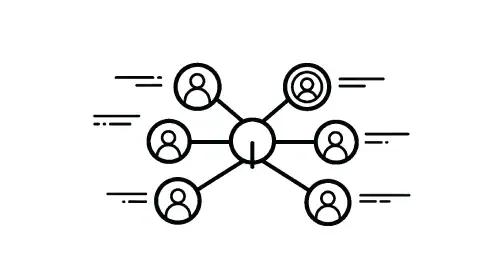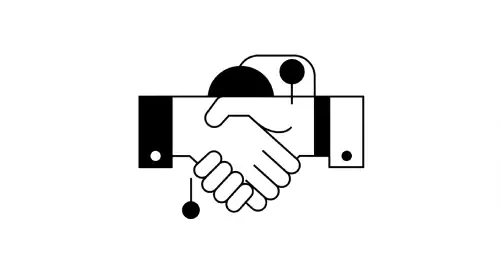Brand Identity Design
Crafting Unique Visuals and Strategies: Our Brand Identity Agency Delivers Results
For over two decades, Inkbot Design has specialised in creating powerful brand identities for businesses of all sizes. We delve deep to unearth your unique brand essence, translating it into compelling visuals and actionable strategies that resonate with your audience.
Brand Identity Design Services

Brand Strategy: Building a Strong Foundation
Whether you're launching a new venture or revitalising an existing one, our process-driven brand strategy lays the essential groundwork for success. We collaborate closely, from initial consultation to final execution, to define a roadmap that ensures your branding not only looks good but also powerfully achieves your business objectives.
Build a Strategy
Brand Development: Crafting Your Unique Connection
Effective brand development forges a memorable link between you and your ideal customer. At Inkbot Design, we move beyond aesthetics to build brand identities that authentically communicate your core messages, drive customer engagement, and ultimately, fuel your business growth and revenue.
Develop your Brand
Rebranding: Evolving Your Brand with Purpose
Undertaking a rebrand is a significant step. Our expertise lies in crafting compelling visual narratives that articulate your renewed vision through intelligent design. From ambitious start-ups ready to launch to established businesses seeking revitalisation after decades, we guide your brand's evolution, ensuring it connects with your audience powerfully while remaining true to its foundational identity.
Refresh your Brand
Corporate Branding: Aligning Identity with Ambition
A misaligned corporate brand can hinder growth and obscure your true value. We partner with businesses to ensure their brand identity meticulously reflects their guiding principles and clearly communicates their proposition to the market. Choose Inkbot Design to develop a sophisticated and impactful corporate brand that builds credibility and supports your long-term strategic ambitions.
Build an EmpireWhy Invest in Your Brand Identity?
A strong brand identity is your greatest asset for winning and retaining customers. It’s the dedicated effort of researching, defining, and building your unique story that translates into tangible value. After all, your brand isn't just a logo; it's the core promise you deliver, shaping perception and driving choice.
Unlock Your Brand's Potential with Inkbot Design
Choosing Inkbot Design for your brand identity offers more than just striking visuals; it delivers strategic advantages:
- Distinctive & Memorable Identity: We craft a unique brand presence that significantly boosts awareness and recognition.
- Emotionally Resonant Visuals: Our designs forge a meaningful connection with your ideal customers, fostering loyalty.
- Competitive Differentiation: Stand out decisively in your market with an identity that highlights your unique value.
- Seamless Brand Consistency: Ensure a cohesive and professional image across all your marketing and communication channels.
- Full Ownership & Clear Guidance: You receive all brand assets and comprehensive guidelines for confident, independent use.
- Versatile & Future-Proofed Design: Your identity is expertly tailored for impact across digital platforms, print media, and beyond.
Ready to build a brand that truly performs? Let's talk.
Discuss Your Brand Vision With Us.
Share a few details, and let our 20+ years of branding expertise guide you towards impactful results.

Trusted by Businesses Like Yours
★ ★ ★ ★ ★
“Working with Inkbot Design was a superb experience – professional, supportive, and insightful. Their creativity delivered a logo that's powerfully established our brand identity on social media. For dependable and creative brand work, look no further. We wholeheartedly recommend Inkbot Design.”

★ ★ ★ ★ ★
“Choosing Inkbot Design for our Brand Identity was an excellent investment. They are inventive, reliable, accessible, and exceptionally thoughtful. Even when I wasn't entirely sure what I wanted, their team expertly listened, grasped the core concepts, and skilfully guided the process to uncover what was truly important. Don't hesitate – bring them on board!”

Strong Branding: The Engine for Your Business Growth
A powerful brand isn't just a ‘nice-to-have' – it's fundamental to your success. Consider the evidence:
- A staggering 89% of B2B marketers identify brand awareness as their foremost goal, placing it ahead of even sales and lead generation in terms of initial priority. This focus is echoed by 70% of brand managers who believe that building a loyal audience is more valuable in the long run than direct sales.
- It's no surprise, then, that 77% of B2B marketing leaders confirm that branding is critical for business growth. For many, 91% of B2B marketers, in fact, effective content marketing is their preferred tool for building this vital brand awareness.
But the impact of branding extends far beyond initial awareness:
- Crucially, 48% of consumers are more likely to develop loyalty to a brand after a positive first experience, and the brand name itself influences the purchasing decisions of 77% of consumers.
- This power of recognition also sways investors, with 82% citing brand strength and name recognition as key factors in their investment choices.
- Ultimately, connection is key. An incredible 90% of all purchasing decisions are influenced by emotion, highlighting the absolute necessity for businesses to cultivate names, messages, and visual identities that resonate positively.
Your brand is your promise, your reputation, and your most powerful asset in driving growth.
Ready to build a brand that not only looks exceptional but truly performs and fuels your business growth? Inkbot Design is here to help you craft a compelling brand identity that connects, converts, and endures.
Ready to stop blending in and start building a brand that commands attention and drives growth?
The next step isn't a hard sell; it's a conversation. Let's discuss your business, your ambition, and how a powerful brand identity crafted by Inkbot Design can get you there.
FAQs (Because Smart Questions Lead to Smarter Branding)
What exactly is “brand identity design”, and why should I care?
Look, your brand identity is how your business shows up in the world – visually and conceptually. It's not just a pretty logo; it's the entire system that makes you instantly recognisable and communicates your core values. You should care because in a crowded market, being memorable and conveying why you're the best choice isn't optional; it's fundamental to winning. Ignore it, and you're choosing to be invisible.
We're a small business/start-up. Is professional branding worth the investment for us right now?
Let me flip that: can you afford not to invest in it? Starting strong with a professional brand identity means you're taken seriously from day one. It builds trust faster, attracts the right customers, and sets a solid foundation for growth. Trying to “save” money here often means spending far more later to fix a weak or inconsistent image. Get it right early; it's leverage.
How is Inkbot Design different from any other branding agency?
Simple. We're not just designers but brand builders with over 20 years of experience helping businesses like yours achieve real-world results. We don't do fluff or chase trends. We focus on strategic, timeless identities that align with your commercial objectives and genuinely connect with your audience. We deliver assets, not just aesthetics.
What's your actual process for developing a brand identity? Do I just tell you what I want?
While your input is crucial, our process is more robust than just taking orders. We start with a deep dive – understanding your business, goals, audience, and competition. Then, we move through strategy, concept development, design refinement, and final delivery of a comprehensive toolkit. It's a collaborative, structured journey to get the best possible outcome, not just the quickest.
How long does a typical brand identity project take with Inkbot Design?
No “typical” exists because every business is unique. A simple logo refresh might be quicker than a complete rebrand with extensive guidelines. However, we don't rush what's essential. We'll give you a clear timeline upfront once we understand the scope. The focus is on quality and strategic impact, not just speed for speed's sake.
What if I don't like the initial design concepts you present?
Our process is built on collaboration and clear communication to minimise this. We have structured feedback rounds. The initial concepts are based on the strategic groundwork we laid together. Our job is to interpret your needs and market realities into practical design. We listen and iterate, and we're committed to creating an identity you're not just happy with but one that works for your business.
What do I actually get at the end of the project? Is it just a logo file?
Far from it. You'll receive a comprehensive brand identity toolkit. This typically includes your primary logo in various formats, colour palettes, typography guidelines, and other core visual elements. Depending on the project scope, it can also include brand guidelines documentation, social media assets, and more – everything you need to implement your new brand consistently and professionally. It's about empowering you.
We already have a logo. Do we need a full brand identity service?
A logo is just one piece of the puzzle. A brand identity encompasses your overall visual language, messaging tone, and how you apply your visuals across different platforms – the whole experience. If a cohesive system doesn't support your current logo, or if your business has evolved, then yes, a broader brand identity service is likely needed to ensure consistency and impact.
How much does brand identity design cost with Inkbot Design? Can I get a quick quote?
Every project is tailored, so a “quick quote” without understanding your specific needs wouldn't be accurate or fair to you. We need to understand the scope, your objectives, and the deliverables required. Think of it as investing in a critical business asset, not just buying a commodity. We provide detailed proposals after an initial discussion.
Why shouldn't I use a cheap online logo maker or a freelancer from a budget platform?
You get what you pay for. Those options might give you a generic mark, but they won't deliver a strategic, differentiated brand identity based on a deep understanding of your business and market. That's like comparing a bespoke suit to something off a discount rack – one fits perfectly and makes a statement, the other… often doesn't. We build assets that generate ROI, not just fill a space.
We're considering a rebrand. How do you ensure our existing customers aren't alienated?
That's a key consideration in any rebrand. Our process involves understanding your existing brand equity – what's working and what your current customers value. A successful rebrand is an evolution, not a complete severing from your heritage, unless necessary. We aim to bring your loyal customers along while attracting new ones by clearly communicating the “why” behind the change.
What industries does Inkbot Design specialise in?
With over two decades of experience, we've successfully partnered with companies across various sectors. Our core strength lies in our strategic branding process, which is adaptable and practical regardless of the industry. Strong branding principles – clarity, differentiation, and connection – are universal.
How involved will I need to be in the branding process?
Your involvement is key, especially during the initial discovery and strategy phases and at critical feedback points. We need your insights and expertise on your business. However, we also do the heavy lifting. We manage the project efficiently to respect your time while ensuring we get the input needed to deliver a brand identity that truly reflects your vision and goals.
What happens after the brand identity is designed? Do you offer ongoing support?
We equip you with comprehensive brand guidelines to manage your new identity effectively. For many clients, the initial project starts a longer-term relationship. We can discuss ongoing support, brand management, or future design needs as your business grows and evolves. Our aim is your long-term brand success.
